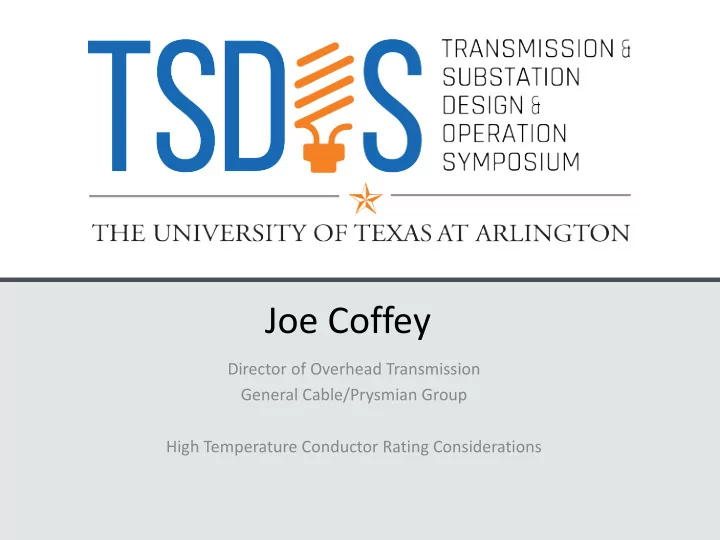

Joe Coffey Director of Overhead Transmission General Cable/Prysmian Group High Temperature Conductor Rating Considerations SEPTEMBER 5 - 7, 2018
IEEE Standard 738 Heat Balance Equation Convection Emitted Thermal cooling Radiation Solar Absorption I 2 R losses SEPTEMBER 5 - 7, 2018
Scenarios for current/temperature relationship 1590.0 kcmil 54/19 Falcon/ACSS 20-49 °C 20-49 °C Frequency: 60 Hz Ambient Temperature: 35 °C 20-49 °C 20-49 °C 0-6 ft/s 0.24-0.9 Emissivity: 0.5 Crosswind Velocity: 2.00 ft/s 20-49 °C 0.0-1.0 Absorptivity: 0.5 Wind Angle: 90 ° Total Solar Radiated Heat: 98.4 W/ft² Northern Latitude: 32 ° Azimuth of Line: 90 ° (E-W) Elevation: 774 ft Atmosphere: clear Month and Day of Year: July 1 20-49 °C 200°C (392°F) Maximum Operating Temp 200 °C Time of Day: 12 PM IEEE 738 equations show ampacity= 2449 Amps 20-4 ??? SEPTEMBER 5 - 7, 2018
Ambient Temperature: vary from 49°C (120°F) to 20°C (68°F) Sensitivity 3200 Ampacity Rating @ 200°C vs. Ambient Temp 29°C (52°F) change 3000 equals 7.6% change in ampacity rating 2800 Ampacity Worst Case: 2600 2539 2480 Winter rating (20°C) 2418 2359 2400 used when actual Temp=49°C 2200 Temp Conductor= 2000 225°C actual vs. 200°C 49°C 40°C 30°C 20°C Ambient Temperature expected SEPTEMBER 5 - 7, 2018
Cross Wind Velocity: vary from 0 ft/s to 6 ft/s Sensitivity Ampacity Rating @ 200°C vs. Wind Speed 3200 0 to 2ft/s = +12.9% 3043 0 to 4ft/s = +27.9% 3000 0 to 6ft/s = +40.3% 2776 2800 Ampacity Worst Case: 2600 Wind stops blowing 2449 2400 for period of time on line rated @6ft/s 2169 2200 Temp Conductor= 2000 340°C actual vs. 0 ft/s 2 ft/s 4 ft/s 6 ft/s Wind Speed 200°C expected SEPTEMBER 5 - 7, 2018
Absorptivity ( α ): vary values from 1.0 to 0.0 Sensitivity 3200 100% change in value Ampacity Rating @ 200°C vs. Absorptivity 3000 equals 5.4% change in ampacity rating 2800 Ampacity Worst Case: 2600 2513 2481 Assume no sun 2417 2384 2400 absorbed when actual α =1.0 2200 Temp Conductor= 2000 218°C actual vs. 1 0.75 0.25 0 Absorptivity 200°C expected SEPTEMBER 5 - 7, 2018
Emissivity ( Ɛ): vary from 0.24 to 0.9 3200 Ampacity Rating @ 200°C vs. Emissivity Sensitivity 3000 0.66 change in value 2781 2800 equals 26.1% change Ampacity 2621 in ampacity rating 2600 2449 2400 Worst Case: 2205 2200 “shiny” new line rated with Ɛ=0.9 2000 Temp Conductor= 0.24 0.5 0.7 0.9 Emissivity 326°C actual vs. 200°C expected SEPTEMBER 5 - 7, 2018
Summary of impact of variables 3200 Ampacity Rating Sensitivity @ 200°C 3000 Ampacity Rating 2800 2600 2400 Night Time 2200 0 ft/s 6 ft/s 49°C 20°C 0.24 1.0 0.9 2000 Absorptivity Temperature Emissivity Wind speed Impact from wind speed and emissivity much greater than ambient temp and absorptivity SEPTEMBER 5 - 7, 2018
Summary of impact of variables at 90°C vs. 200°C Line Rating Sensitivity Comparison 1000 874 Added Ampacity from change 900 799 800 700 576 600 500 429 @90°C Series2 400 277 300 204 @200°C Series3 180 200 116 100 0 Absorptivity: Emissivity: Ambient Temp: Wind Speed: Reduce from Increase from Reduce from Increase from 1 to 0 0.24 to 0.9 49°C to 20°C 0ft/s to 6 f/s SEPTEMBER 5 - 7, 2018
EPRI test results from Texas. What value to use? Age Measured (Years) Emissivity Location Conductor 0 0.24 - ACSR-Drake 3 0.25 Amarillo ACSS-Falcon 32 0.32 DFW ACSR-Bittern 32 0.45 Austin ACSR-Drake SEPTEMBER 5 - 7, 2018
Lower Pollution equals lower emissivity S0 2 N0 X Suspended Particulates SEPTEMBER 5 - 7, 2018
For HTLS Conductors, Emissivity Matters. Peak Temp = 265°C Emissivity = 0.24 Peak Temp = 187°C Emissivity = 0.9 SEPTEMBER 5 - 7, 2018
If actual Ɛ =0.3/ α =0.3, what would conductor temp be with commonly used rating methodology Ɛ/α value sets? Calculated Conductor Temperature 350 286 274 300 254 229 250 215 200 200 °C 150 100 2292 A 2372 A 2449 A 2573 A 2667 A 2724 A 50 0 0.3/0.3 0.4/0.4 0.5/0.5 0.7/0.9 0.8/0.8 0.9/1 Emissivity/Absorptivity SEPTEMBER 5 - 7, 2018
Line Rating observations for High Temperature Lines Emissivity and Wind Speed are major contributors • Emissivity is measurable • Actual emissivity values are likely lower than • commonly used values HTLS conductor ratings are particularly sensitive to • emissivity changes. Consistency of line rating “philosophy” should be • reevaluated for HTLS conductors vs. traditional ACSR SEPTEMBER 5 - 7, 2018
Recommend
More recommend